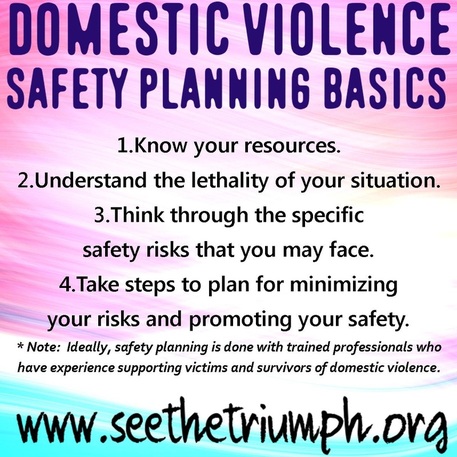|
By Christine Murray, See the Triumph Co-Founder
A safety plan is a basic tool that victims of domestic violence can use to identify risks to their safety and well-being and plan strategies for protecting themselves in the face of those risks. A couple years ago, my Family Violence Research Group at the University of North Carolina at Greensboro developed the Safety Strategies: Safety Planning for Survivors of Domestic Violence and Their Children booklet as a resource for professionals to use to conduct safety planning with their clients who face domestic violence. Our goal was to use the information we learned through our research with professionals working with 9 domestic violence agencies to present a comprehensive, practical approach to safety planning. Ideally, safety planning is done with professionals who have experience working with victims and survivors, because they are trained to help survivors identify the most pressing risks and helpful strategies to reduce those risks. If you or someone you know is currently experiencing domestic violence, I recommend you reach out to the National Domestic Violence Hotline (http://www.thehotline.org/; 1-800-799-7233) and/or a professional in your local community to walk through the process of developing a safety plan that reflects your current circumstances. Based on the Safety Strategies booklet, we offer the following safety planning suggestions to help people who are currently facing safety risks due to a current or former abusive relationship:
Comments are closed.
|
Archives
July 2024
CategoriesAll About Intimate Partner Violence About Intimate Partner Violence Advocacy Ambassadors Children Churches College Campuses Cultural Issues Domestic Violence Awareness Month Financial Recovery How To Help A Friend Human Rights Human-rights Immigrants International Media Overcoming Past Abuse Overcoming-past-abuse Parenting Prevention Resources For Survivors Safe Relationships Following Abuse Schools Selfcare Self-care Sexual Assault Sexuality Social Justice Social-justice Stigma Supporting Survivors Survivor Quotes Survivor-quotes Survivor Stories Teen Dating Violence Trafficking Transformative-approaches |
Search by typing & pressing enter



 RSS Feed
RSS Feed